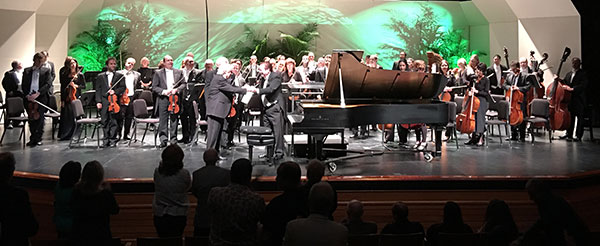
FORT LAUDERDALE, FL -- Music of Russia and Spain formed the bill of fare for the Symphony of the Americas' final concert of the season on Tuesday night at the Broward Center's Amaturo Theater. Manuel de Falla's Nights in the Gardens of Spain formed the program's center piece. Part piano concerto, part impressionistic tone poem, Falla's unique score requires a pianist of virtuosic stature and refined artistry. Joaquín Achúcarro has graced the world's concert stages for over half a century. He is an honored and highly valued professor at Southern Methodist University in Dallas and at the renowned summer academy in Siena, Italy. Achúcarro has performed in concert halls across the globe and has soloed with nearly every major orchestra in the world. His performance of Falla' masterpiece was nothing short of extraordinary, celebrating the 100th anniversary of the April, 1916 premiere of the score with José Cubiles, one of Achócarro's teachers as soloist.
Right from the score's opening measures, Achúcarro and Symphony of the Americas artistic director James Brooks-Bruzzese established the music's Andalusian aura. Orchestral textures were clear and transparent . Achúcarro's crystalline touch and depth of tone vividly evoked Falla's perfumed scented portrait of the Generalife, the garden around the Alhambra. His sensitivity and idiomatic fluency brought out the score's wonderful Spanish flavored impressionism. Brooks-Bruzzese splendidly evoked the movement's languid atmosphere, the strings playing with tonal luminance and variegated coloration.
The exotic Danza le jana took wing with Achúcarro's incisive rhythm and superb articulation. The tricky hand crossings were smoothly achieved. Beyond the purely technical demands which were expertly realized, Achúcarro brought deep musical expression and masterful interpretive feeling for every bar. This was playing in the grand manner of such past masters as Rudolf Serkin, Walter Gieseking and Arthur Schnabel. The folk inflected strophes of Falla's delineation of gardens in Córdoba found Achúcarro and Brooks-Bruzzese in peak form, the driving momentum giving full rein to both the pastel instrumental textures and the brilliant keyboard writing. At full force Achúcarro's firepower proved formidable. The outstanding playing of the ensemble's winds and harp were particularly notable in a performance that did full justice to Falla's sonic landscape.
The program opened with Alexander Borodin's miniature tone poem In the Steppes of Central Asia. A sound picture of the deserted steppes with a caravan approaching in the distance, then passing by and the landscape returning to silence, the score is a melodic and colorful orchestral showcase. Alex Caballero's opening clarinet solo was full toned and beautifully shaped, the initial fragment of the work's main theme. Brooks-Bruzzese's tautly paced reading captured Borodin's exoticism. Eric Kerley's clarion horn resounded brilliantly and the cellos encompassed the secondary subject in warm and rich sonorities. Marilyn Maingart's final repetition of the haunting theme on solo flute put the exclamation point on a deftly played opener.
Tchaikovsky's Symphony No. 2 in C minor (Little Russian) is too rarely played. Kudos to Brooks-Bruzzese for reviving this terrific score. While Tchaikovsky's final three symphonies have proven his most popular with orchestras and audiences alike, the Russian master's first three symphonies are also fine works, replete with Tchaikovsky's typically inspired melodies and vibrant orchestration.
The 2nd Symphony is particularly notable for its quotation of Russian folk sources. An opening horn solo references the Ukrainian tune Down by the Volga, a melody similar to the iconic Volga Boatman song. The Symphony of the Americas' winds were particularly forthright and spot on in the melody's reprise. Brooks-Bruzzese took a brisk tempo in the ensuing Allegro vivo with strings articulating the vigorous theme in gutsy fashion. The conductor's flowing pace gave space and rays of musical light to the balletic second subject. There was plenty of stormy power in the development before Tchaikovsky's singularly original coda which brings back the indigenous theme of the introduction, finely assayed by the orchestra's horn and bassoon principals.
Instead of a tradition slow movement, Tchaikovsky conceived an Andante marziale. Repeated timpani strokes heralded the march rhythm played deftly by the winds. The middle section is strongly contrasted, a soulful Russian theme which was replete with fervor in the playing of the solo clarinet and strings. A scampering melody propels the Scherzo. Brooks-Bruzzese finely emphasized the distinctive textures of the individual choirs of the orchestra while maintaining strong rhythmic cohesion.
The folk melody The Crain forms the basis of an elaborate theme and variations finale. Brooks-Bruzzese's crisp tempo and the full bodied corporate ensemble gave full thrust to this energetic, thoroughly Russian dance theme. The strings exhibited fine precision in the lyrical secondary melody and, in the fiery coda, the brass section was solid and sonorous with the first rate percussion battery having a field day right up to the final chords.
A standing, cheering ovation brought a delightful encore - Johann Strauss, Jr's Thunder and Lightning Polka, played with zest and pizzazz. A joyful conclusion to an outstanding season!
The Symphony of the Americas presents Summerfest 2016 with James Brooks-Bruzzese conducting the Summerfest Chamber Orchestra featuring musicians from 10 different countries and members of the Symphony of the Americas 6: 00 p.m. July 17 at the Broward Center in Ft. Lauderdale 954-335-7002 www.sota.org




















